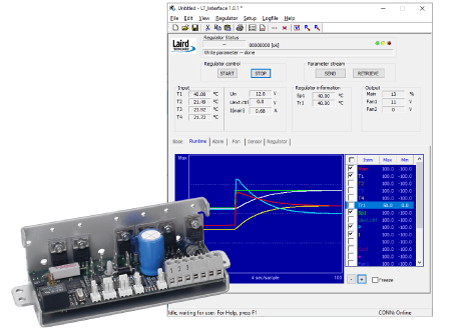Clone of Nextreme™ NRC400-T0-00-PC2 Performance Chiller (Chinese - 中文)
Laird Thermal Systems’ Outdoor Cooler Series is an Air-to-Air thermoelectric cooler assembly that uses impingement flow to transfer heat. It offers dependable compact performance by cooling objects via convection and is designed to provide cooling for a wide range of outdoor environments in the telecom, industrial and kiosk markets. They are intended to work in an open loop system or if purchased with a bi-directional controller in a closed loop system with feedback control.
热电冷却器组件的温度控制
 液冷システムには専用のコントローラか、市販の汎用コントローラが備えられており、温度の安定化と使い勝手を改良しています。
液冷システムには専用のコントローラか、市販の汎用コントローラが備えられており、温度の安定化と使い勝手を改良しています。
当社のNextreme™再循環チラープラットフォームの特長は、熱電ベースの冷却システムには±0.05°C以下、コンプレッサベースの冷却システム用には±0.1°C 以下の極めて高い温度安定性が得られる先進ソフトウエアを搭載していることです。Nextremeのインターフェイスは直感的に理解できカラーのタッチスクリーンディスプレイを特長としているので、ユーザーはシステムの設定を直接コントロールし管理できます。
热电冷却器组件的温度控制
 莱尔德热系统的温度控制器是基于我们自己开发的平台,旨在控制闭环系统中热电冷却器组件。来自温度传感器的反馈用于改变控制器的输出,以保持物体或外壳的正确温度。
莱尔德热系统的温度控制器是基于我们自己开发的平台,旨在控制闭环系统中热电冷却器组件。来自温度传感器的反馈用于改变控制器的输出,以保持物体或外壳的正确温度。
当与温度控制器结合使用时,莱尔德热系统的热电冷却器组件能够在以加热和冷却模式运行的稳态条件下实现 ±0.05°C 的温度稳定性。
温度控制器特性
我们的温度控制器可以根据控制器的具体类型提供各种功能。
PowerCycling PCX Elongated Thermoelectric Coolers Speed up PCR Testing Reports Laird Thermal Systems
To improve temperature precision control in PCR devices, Laird Thermal Systems has developed an elongated series of PowerCycling PCX thermoelectric coolers. Utilizing proprietary processes and a unique module construction, the PCX Elongated Series provides high reliability and a minimal temperature gradient for PCR applications resulting in greater throughput and faster test results.
Read more here: https://infomeddnews.com/powercycling-pcx-elongated-thermoelectric-coolers/
Laird Thermal Systems Launches Alternative Refrigerant-Based Cooling Systems Initiative
Laird Thermal Systems has launched an initiative to introduce the use of alternative refrigerants in refrigeration-based cooling systems to address global warming and changes in regulatory requirements in the cooling industry.
Learn About Temperature Controllers
单向恒温控制器可以使处在相对稳定环境温度的外壳内保持恒定的设定温度。温度设定点容差由滞后范围确定,一旦达到设定温度,控制器就会关闭热电冷却器组件。当温度变化到滞后范围之外时,控制器接通热电冷却器组件电源并重新启动冷却模式过程,这个循环可一直持续到控制器关断。恒温控制通常用于带空调控制的室内环境冷却模式,在这种环境中可以具有较窄的温度波动。莱尔德热系统可提供两种标准的单向恒温温度控制器QC-50和QE-50。
